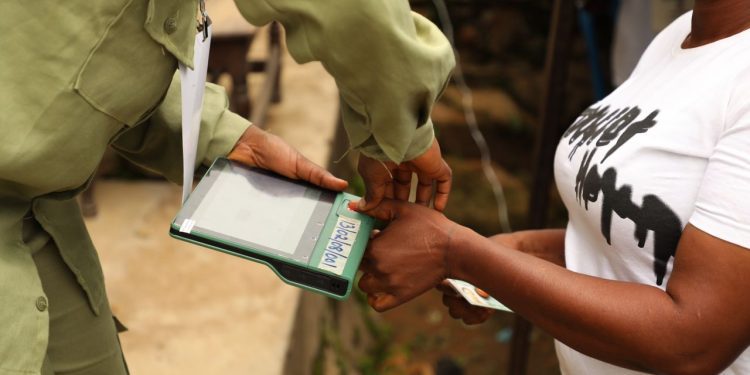The Independent National Electoral Commission (INEC) deployed a new technology for voter accreditation to increase electoral credibility in the Ekiti election on June 18 and this will be a major litmus test for the country. The voter accreditation technology, the Bimodal Voter Accreditation System (BVAS) is made mandatory by the new Nigeria Electoral Act 2022 in section 47(2) (3). The BVAS was designed to replace the Smart Card Reader for verification and authentication as part of the improved voter accreditation process.
BVAS reads the Permanent Voter Cards (PVCs) and authenticates voters – using the voters’ fingerprints – in order to prove that they are eligible to vote at a particular polling unit. Its usage entails either scanning the barcode/QR code on the PVC/Voter’s register or entering the last six digits of the Voter Identity Number or typing in the last name of the voter by the Assistant Presiding Officer (APO 1) to verify and authenticate the voter.

According to the INEC Chairman, Professor Mahmood Yakubu, “When the commission introduced BVAS last year, the compact device was intended to achieve two objectives. First is the verification of the genuineness of the PVCs and the fingerprint or facial authentication of voters during accreditation. Secondly, to replace the Z-pad for uploading the polling unit results to the INEC Result Viewing Portal (IReV) in real-time on election day. It also acts as the INEC Voter Enrolment Device (IVED) during voter registration. Its usage has also eliminated the use of incident forms during accreditation on an election day.”
The BVAS has been previously deployed for the accreditation of voters in the Isoko-South 1 State Constituency bye-election in Delta State in September 2021. It was also deployed in the November 2021 Anambra governorship election, the February 2022 FCT Area Council Election, and the March 2022 bye-elections in Ondo, Cross Rivers, Jos, and Imo States.
Apart from BVAS technology, INEC has also introduced uploading of Polling Unit results on the INEC Result Viewing (IReV) portal in real-time on Election Day.
Nigeria is yet to fully incorporate electronic voting technology which can help her speed up the counting of ballots, reduce the cost of paying staff to count votes manually, and can provide improved accessibility for disabled voters. The cost of running elections is expected to decrease and results can be reported and published faster.
As of May 18, 2022, INEC says 988,923 registered voters are eligible to participate in the Ekiti state June 18 election and of these 720,724 have collected their permanent voter’s cards. Of the registered voters 502,906 (51%) are females and 486,017 (49%) are males while the Youths (18-34) constitute 38.56% of the total voters. The BVAS deployment will play a central role in safeguarding this election.
Bisi Kolawole, the PDP Governorship candidate believes “BVAS is a significant improvement unlike before when we have to go home after accreditation. So far there have been no issues about using BVAS for accreditation.” He added that “we have a lot of security men on the ground. I hope they will maintain the peace”.
INEC said it deployed 3,346 BVAS across 177 wards with 2445 polling units in all 16 Local Government Areas (LGAs) in Ekiti state for the election.
BVAS was largely successful – NGOs
According to an NGO, Center for Democracy and Development, which deployed several observers for the Ekiti Elections “the deployment of the Bimodal Voter Accreditation System (BVAS) was largely very successful. As of 6 pm, our data showed that 84.3% of polling units covered had transmitted their results via BVAS. Likewise, the INEC Result Viewing Portal (IReV) was also in full operation for the uploading of results in most of the polling units covered by our observers. As of 9.42 pm when the CDD-EAC closed on election day, 99.7% of the results were available on the IReV. This level of compliance is commendable and should be the benchmark for future elections.”
YIAGA Africa, a nonprofit organization that promotes democratic governance, human rights, and civic engagement, deployed over 500 observers to the Ekiti election. In a statement issued after the election, YIAGA reported that “in 92% of polling units, the BVAS functioned properly. However, in 8% of polling units, the BVAS malfunctioned and it was fixed. In 96% of polling units, the BVAS had zero records for the total number of accredited voters on the BVAS before the commencement of the process. In 34% of polling units, some voters were refused accreditation because the BVAS did not verify their PVC or authenticate their fingerprints or facial biometrics.
“There was a report from Ilabo in Ire ward II, Front of Fagbemigun’s House with PU Code 016 of Oye LGA, that polling officials failed to use the BVAS to verify voters’ fingerprint or for facial recognition. This led to the disruption of the process by aggrieved party agents.’’ YAIAGA observed.
YIAGA Africa reported that it received and verified three reports of missing names of registered voters on the BVAS. The voters were prevented from voting despite holding INEC-issued PVCs. Upon further investigation, Yiaga Africa discovered the voters were allocated to new polling units but INEC failed to communicate the reallocation to the voters, and neither did the Commission update the voter records on the online portal for voter status verification.
The Ekiti State Governorship election result, contested by 16 candidates, as declared by INEC shows that the candidate of the All Progressives Congress (APC), Mr. Olatunji Oyebanji scored 187,057 votes (53.16%) to defeat his closest challenger, Mr. Segun Oni of the Social Democratic Party (SDP), who polled 82,211 (23.37%) of the votes, while Mr. Bisi Kolawole of the Peoples Democratic Party (PDP) came third with 67,457 (19.17%) of the votes.
The election recorded 36.5% voter turnout, the lowest since 2003. Only 360,753 people out of the total 988,923 registered voters voted. The 2003 election had a 43.5 percent turnout, 2014 had 49.1 percent and 2018 had 44.4 percent.
This story was produced with the support of the Media Support Center.

